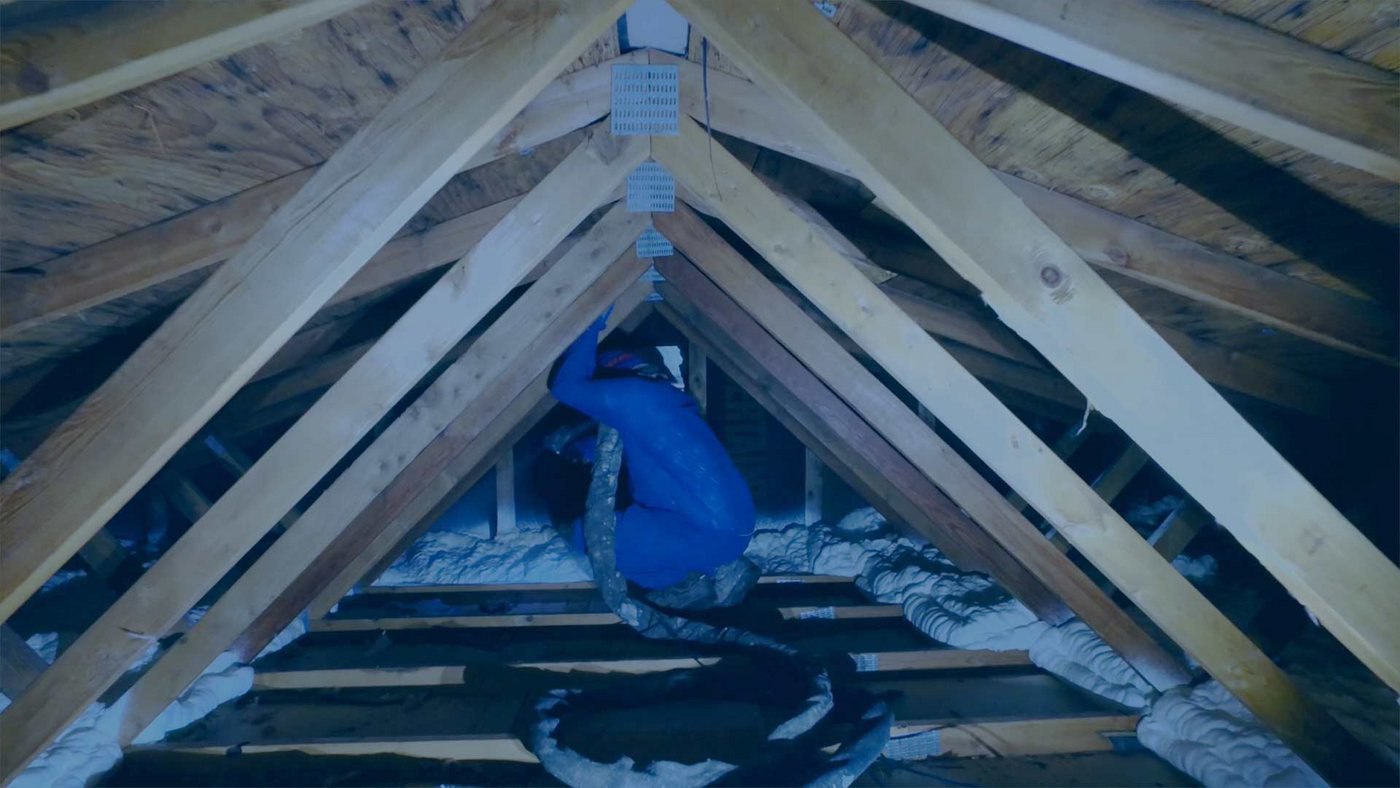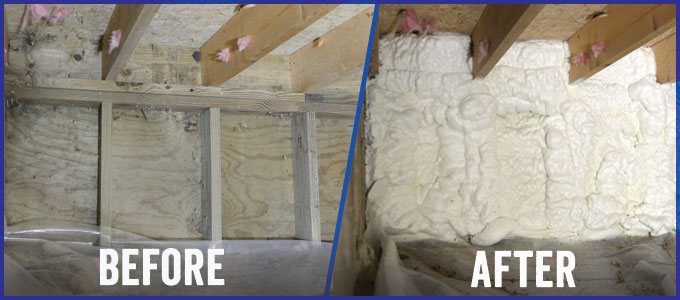Foam vs Fiberglass vs Cellulose: Which Insulation is Best for My Existing House?


You know your home is in need of insulation, but now comes the tough decision – do you use spray foam or injection foam, fiberglass, or cellulose?
So, why is insulation so important for your home?
Home insulation is what keeps the air you're paying to heat and cool inside where you want it and Mother Nature outside. This also helps to keep your air conditioner and furnace from working overtime to keep up, as long as the insulation isn't allowing for air leaks and has been routinely maintained.
Another thing you want your insulation to do is to seal your home's building envelope. The building envelope is what separates your living space from the great outdoors. Not all insulation material create the air seal needed to seal the building envelope, which just adds one more piece of research for you as you choose the right insulation for your home.
Choosing the right home insulation can be a daunting task while you take into consideration the cost of the material, how effective an insulation material will it be, and will it end up saving you money in the long-run.
RetroFoam of Michigan has more than 17 years of experience insulating thousands of homes across the lower peninsula, so we know quite a bit about all insulation materials.
In an effort to provide our customers with all the information available so they can make an informed decision, we have information about each area of the house and which different types of insulation materials work in those spaces.
Let’s take a look at the best types of home insulation and what that looks like for each area of the house.
Best Insulation Material: Cellulose vs Fiberglass vs Foam Insulation House Insulation Comparison
Before we get into all of the specifics of each area of the house and each material, here's a chart that will break down the differences between cellulose vs fiberglass vs foam insulation.
This house insulation comparison chart shows where each insulation material stands when it comes to home comfort, energy savings, installation method, and a lot more.

Let's take a closer look at some of these house insulation comparisons to get a better understanding of what we're working with.
The comfort of your home is an important factor when it comes to insulation. Looking at the chart you can see that spray foam has a higher rating, as it creates an air seal that isn't possible with fiberglass and cellulose. That air seal also lends itself to the energy savings you will see in your home, because your furnace and air conditioner won't have to work overtime to maintain a constant temperature.
In your insulation research I'm sure you've read a ton about R-Value, and now you're wondering which insulation offers the highest R-Value. For the purpose of this chart the spray foam range is for both open and closed cell spray foam. It's also important to note that these values are per inch of each product.
So, does a higher insulation R-Value mean it's the best option for your home? No, because it boils down to the R-Value versus creating an air seal.
You might hit the R-Value you want, but if it doesn't create that air seal then you still have air movement which effects the comfort and energy efficiency of your home.
Safety is another important aspect about anything you put inside your home. All three of the insulation options have materials on the market that are Class One Fire Rated. What that means is, if the materials have this rating, the insulation won't serve as a catalyst if there were a fire in your house.
Lastly, I'd like to discuss the cost and maintenance together. As you can see in the chart, fiberglass is the cheapest, cellulose comes in second, and spray foam has the highest initial cost. The reason maintenance is good to talk about when you talk about cost is because both fiberglass and cellulose must be maintained and eventually replaced over time, while spray foam is one and done, meaning it doesn't need any kind of maintenance and won't need to be replaced.
Now that all of that is out of the way, let's look at your house starting at the top and head on down to the bottom.
Spray Foam vs Cellulose vs Fiberglass for Attic Insulation
 If you’re looking to cut down on the amount of money pouring out through your roof, attic insulation is the way to go.
If you’re looking to cut down on the amount of money pouring out through your roof, attic insulation is the way to go.
High energy bills and the inability to maintain a constant temperature are just some of the problems you'll notice when your attic needs new or updated insulation. The best types of home attic insulation are open cell spray foam, fiberglass, and cellulose.
Cellulose is the oldest insulation material used for not only the attic but other areas of the home as well. Cellulose can be either a loose-fill or blown-in material and is primarily made of recycled newsprint or denim.
Cellulose can be a DIY project and is fairly inexpensive when it comes to insulating attics in comparison to other insulation materials. On the flip-side of that, cellulose can settle up to 20 percent, can shift to one side of the attic, and it doesn’t create an air seal. This means cold and hot air can move freely through the attic without any barriers, raising monthly energy bills.
Fiberglass is another traditional insulation material that consists of extremely fine glass fibers.
Fiberglass can be installed as a DIY project and is inexpensive. The downside of fiberglass is that the fibers it is made up of can be inhaled and even embed in the skin. It also still allows for airflow into the attic.
Open cell spray foam insulation is an air barrier material that creates a seal against air movement. It can expand up to 100 times its original size, filling every nook and cranny in the attic. Its main ingredients are water-blown and organic chemical compounds derived from petroleum extracts making it environmentally safe.
Spray foam is Class One Fire Rated for the attic, which means it won’t serve as a catalyst if there were a fire. It also doesn’t retain water that will promote mold and mildew growth, it creates an air seal that helps lower monthly energy bills, and creates a semi-conditioned space by insulating the roof deck in an unvented attic.
The downside of spray foam is that it is more expensive than traditional forms of insulation and is too complex for a DIY project, so a contractor must install it.
READ MORE: What is the Best Attic Insulation?
Best Insulation for Existing Walls: Blown-In Cellulose vs Injection Foam
 When it comes to the existing walls of your home there is no easy way to tell you this, but the insulation must be installed by an experienced contractor.
When it comes to the existing walls of your home there is no easy way to tell you this, but the insulation must be installed by an experienced contractor.
The good news is you can add insulation to the existing walls without removing your drywall and the extra expense of a full remodel.
Injection foam insulation and blown-in cellulose can be installed in the existing walls through similar methods. First, a row of siding is removed, a hole is drilled into each stud cavity, the material is then injected or blown-in until the cavity is full, the hole is plugged, and the siding is replaced.
When insulation does its job, it impacts the conduction (heat transfer) and the convection (airflow), which can both impact the comfort and energy efficiency of your home.
More traditional house insulation types, like cellulose, is resistant to heat that is transferred through conduction. During the winter months, that heat transfer is from the inside of your home to the outside and vice versa in the summer.
Airflow allows the movement of air in and out of your house through gaps in the walls and electrical outlets. This air leakage contributes to a critical source of the home’s energy loss. It also contributes to discomfort in your home such as drafts, cold floors, and cold walls.
To reduce this air leakage, foam insulation works best because it provides heat resistance and an air seal.
Another problem you might notice due to air leakage and not having enough insulation in your walls is condensation on the walls or moisture in the wall cavity, which can lead to mold and mildew growth.
Spray Foam Insulation vs Fiberglass: Best Crawl Space Insulation
 When looking at the best insulation materials to use in the crawl space the conversation is typically foam insulation vs fiberglass.
When looking at the best insulation materials to use in the crawl space the conversation is typically foam insulation vs fiberglass.
The walls of the crawl space should be insulated with non-water sensitive insulation that will prevent interior air from touching the cold surfaces. Allowing the interior air that is regularly full of moisture can cause condensation and promote mold and mildew growth, according to the Building Science Corporation.
The crawl space can be an area that sees more moisture than other areas of the home.
This doesn’t make fiberglass a great fit for the area. When fiberglass gets wet, the water accumulates in the pockets of the material and drastically reduces its insulating properties. This means you will have to replace it if you want your insulation to work down there.
Spray foam is the better choice between the two because it doesn’t retain water and it creates an air seal. Fiberglass is the cheaper option and you can install it yourself, but spray foam creates the air seal you will want in the space.
The Building Science Corporation recommends a foam-based insulation material for crawl spaces because of this.
READ MORE: What is the Best Crawl Space Insulation?
Best Rim Joist Insulation: Foam Insulation vs Fiberglass
 The rim joist is one of the most overlooked areas of the home when you are looking for the culprit causing drafts around your floorboards.
The rim joist is one of the most overlooked areas of the home when you are looking for the culprit causing drafts around your floorboards.
The insulation options for the rim joist is spray foam or fiberglass.
Fiberglass is inexpensive and you can install it yourself, but it does not do as good of a job insulating the rim joist, according to Home Construction Improvement. The material when installed in the rim joist also is prone to mold issues as it holds condensation against the wood, which leads to mold and decay formation.
Spray foam doesn’t retain water, so it doesn’t have the same moisture issue as fiberglass. It will also create an air seal that keeps the outside air from getting in while reducing the drafts near the floorboard.
Fine Home Building recommends only air-impermeable insulation for the rim joist – either spray foam or rigid foam boards.
READ MORE: What is the Best Rim Joist Insulation?
Choosing the Best Insulation Material for Your Existing Home Insulation
At the end of the day, the choice is yours when it comes to selecting the best type of home insulation material for your existing home.
To see what makes the most sense for your family you will need to take into consideration the pros and cons of each insulation material, the goals you are looking to accomplish, and your budget.
Overall, if you are looking for the best long-term solution, foam insulation products will create the air seal in your home that will make it more comfortable while saving you money on your monthly energy bills. Foam insulation doesn’t settle or sag and it fills all the nooks and crannies where it is installed.
On the other hand, if you want a DIY option and costs less, then traditional insulation may be the best option for you.
If you agree with Fine Home Building and the Building Science Corporation that foam insulation is the best fit for your existing home and live in Michigan’s Lower Peninsula or the greater Toledo area, give us a call at 866-900-3626 for a free consultation or fill out the form on our website.
Related Articles
When is it Time to Replace the Insulation in My Existing Home?
How Air Sealing Insulation in Your Home Works Like Your Airtight Cooler
What is the Best Way to Install Insulation? (DIY vs Hiring an Insulation Contractor)
About Amanda Emery
Amanda previously has worked as a breaking news and crime reporter, TV news producer, and editor in Flint and Detroit. Throughout her career as a journalist, she has won several awards from The Society of Professional Journalists - Detroit Chapter and the Michigan Press Association. As part of the RetroFoam of Michigan family, Amanda uses her experience as a journalist to write content that will help educate homeowners on the benefits of foam insulation. When Amanda isn’t writing, she’s spending time with her husband and rescued huskies. She also loves knitting, making art, cooking, and hosting dinner and a movie night for friends and family.


